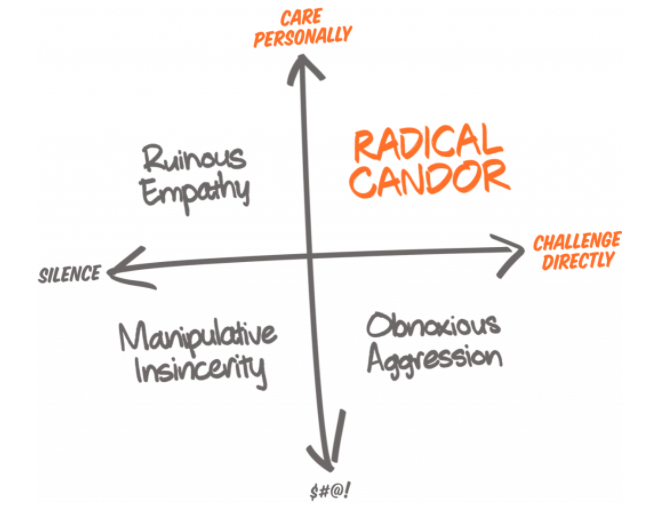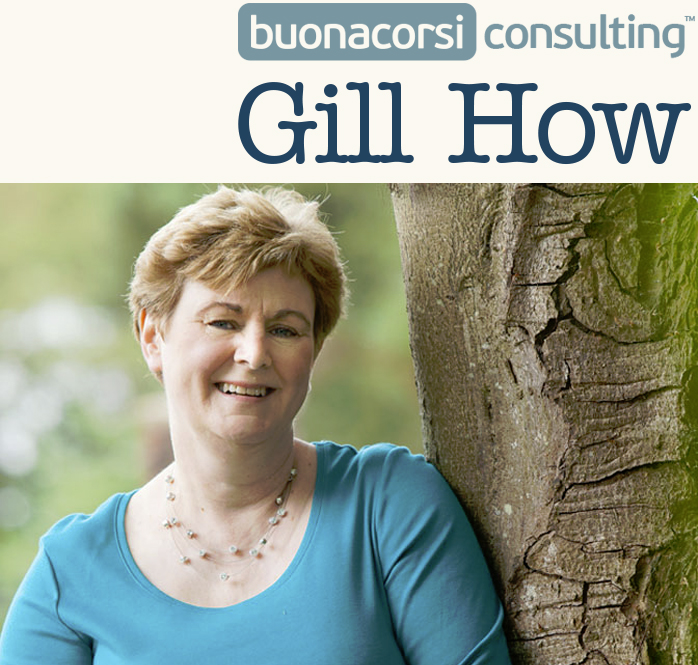Kim Scott, in her book, Radical Candour, tells the story of when she was waiting to cross the road with her golden retriever puppy. Her dog was tugging at the leash.
A stranger said, “I can tell you really love your dog”. He took two seconds to show he was supportive, not judging Kim or her dog training skills.
Then he gave a really direct challenge. “But your dog will die if you don’t teach her to sit”.
He told the dog to sit, in a tone which was clear. He modelled what the puppy needed to learn.
This combination of both care and challenge for Kim allowed her to wake up, listen to the stranger’s feedback seriously and take action on it.
How does this story relate to you, me or the workplace? There are two axes of Kim’s Radical Candour model:
Early in my career, with my well known direct communication style, I could be too strong on challenging others. I didn’t realise the impact I was having. People knew I often had a good point, but found me hard to like.
Without enough supporting care or compassion for the other person, my style was most likely experienced as the Obnoxious Aggression quadrant in the model.
My behaviour did me no favours. If people did adopt my ideas or act on my advice, they did so reluctantly. It did not develop or enhance our working relationship.
In contrast, I can think of at least one colleague who is endlessly supportive, full of empathy. They are in the Ruinous Empathy quadrant. For me personally it can feel great to be on the receiving end; but at some point I really do need some feedback and challenge too if I want to move forward (which I usually do).
We may also have met people at work who offered neither care nor challenge, the Manipulative Insincerity box.
Why does any of this matter?
I believe most of us want to be effective in our relationships at work and in our broader lives too. We want to have a positive impact on others.
To help, it’s the combination of care and challenge that makes the difference. It can make the challenge palatable, and in this way, help others tackle problems, take action and move forward.
I wanted to make my own behaviour more automatic combining both principles. “Clunk Click, Every Trip” came into my mind.
Do you remember this?
It was a campaign to reduce deaths from driving without seatbelts in the UK.
The key message was, as well as the clunk of the car door shutting, let us hear the click of the seatbelt too.
These things need to go together, every time.
The campaign was instrumental in reducing deaths from car accidents.
Clunk, Click is my shorthand now.
It helps me to remember the two things – care and challenge – to use with the person you are working with, so that they move to action.
Deep down inside I think we know this already; that people need to know you are on their side before they can hear what you have to say about how they can improve.
Can Clunk Click help you as your memory jogger to be effective with other people too?
Gill How loves to work with managers, executives and professionals to help them to evolve, stretch and grow their leadership capability. She is a Master Executive Coach and innovative Leadership Developer who works both internationally and in the UK.
Get in touch for a coffee, real or virtual, for an exploratory conversation.
“As a coach, Gill is an excellent listener at a deep level and never failed to ask a provocative question, focus on a specific nugget, or provide an insightful summary. She would play these back to me in a way which deepened my self-awareness and provoked thinking in areas I hadn’t previously considered. Gill’s sessions were practical, gave me the opportunity to develop strategies, explore new ways of thinking and map out next steps.”
Kate Daniel, Senior Strategic Internal Communications Manager, Linklaters
Photo by Clem Onojeghuo from Pexels






